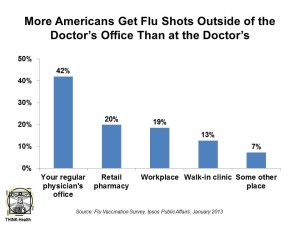4 in 10 Americans got flu shots in this epidemic season, and most of these didn’t receive their immunization in their doctor’s office.
The Flu Vaccination Survey from Ipsos Public Affairs, conducted in January 2013, paints a picture of U.S. health consumers who are project managing their personal approaches to preventing the flu in this historically hard-hitting flu season.
The most expressed demand for flu shots has been among people 55 and over, one-half of whom have received vaccinations, with the lowest use been in the 25-35 year age group. Geographically, the most covered health citizens live in New England (48%), East North Central (43%), Pacific (43%) census regions. The least-vaccinated people live in the southern tier of the U.S., West South Central (30%) and East South Central (33%) regions.
41% of people said that it’s unlikely they’ll get a flu shot this season.
84% of Americans said that washing their hands was a more effective method of fending off the flu than getting the flu shot. 68% said using hand sanitizer was more effective than getting the flu shot. Other self-determined methods of avoiding the flu included:
- Eating healthy, 60%
- Avoiding crowds, 59%
- Being fit, 57%
- Getting the flu vaccine, 56%
- Taking vitamins or supplements, 53%
- Dressing warmly, 49%
- Eating certain foods or beverages, 37%.
16% of Americans believe that the flu vaccine is unsafe, and 20% of people are opposed to vaccination in general, with 21% being neutral on the subject.
For more information on the flu epidemic, visit the CDC’s flu page at Flu.gov which has a helpful Flu Vaccine Finder driven by zip code.
Health Populi’s Hot Points: Three-quarters of Americans say that vaccines are available in the places convenient to them, which is good news for health citizen’s perceptions of flu shot access. In addition, Ipsos found no major barriers to accessing flu shots due to cost (financial barriers). 41% of people said that most of their friends got a flu shot.
The flu season of 2012-13 has had a major impact on certain aspects of the economy. On the macroeconomic front, the labor force has been hard-hit: days of work have been lost, so productivity losses can be expected for 4Q12 and 1Q13. Human resource managers are confused about how to handle the epidemic within their companies. From a microeconomic point-of-view, certain industry segments are benefiting: most notably pharmacy and food retailers; the Palm Beach Daily News reported a spike in pharmacy sales in that community, seen throughout the U.S. As the survey data demonstrate, health consumers seek a variety of strategies to keep the flu at bay.
Consumers’ responses to this season’s flu epidemic — especially the decentralization of flu shot delivery apart from the doctor’s office — demonstrates the growing healthcareDIY movement of people seek products and services outside of the traditional healthcare system.





 Interviewed live on BNN Bloomberg (Canada) on the market for GLP-1 drugs for weight loss and their impact on both the health care system and consumer goods and services -- notably, food, nutrition, retail health, gyms, and other sectors.
Interviewed live on BNN Bloomberg (Canada) on the market for GLP-1 drugs for weight loss and their impact on both the health care system and consumer goods and services -- notably, food, nutrition, retail health, gyms, and other sectors. Thank you, Feedspot, for
Thank you, Feedspot, for  As you may know, I have been splitting work- and living-time between the U.S. and the E.U., most recently living in and working from Brussels. In the month of September 2024, I'll be splitting time between London and other parts of the U.K., and Italy where I'll be working with clients on consumer health, self-care and home care focused on food-as-medicine, digital health, business and scenario planning for the future...
As you may know, I have been splitting work- and living-time between the U.S. and the E.U., most recently living in and working from Brussels. In the month of September 2024, I'll be splitting time between London and other parts of the U.K., and Italy where I'll be working with clients on consumer health, self-care and home care focused on food-as-medicine, digital health, business and scenario planning for the future...